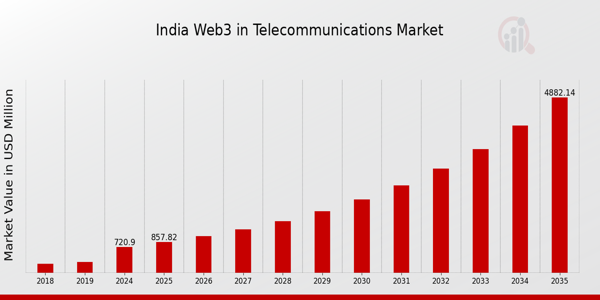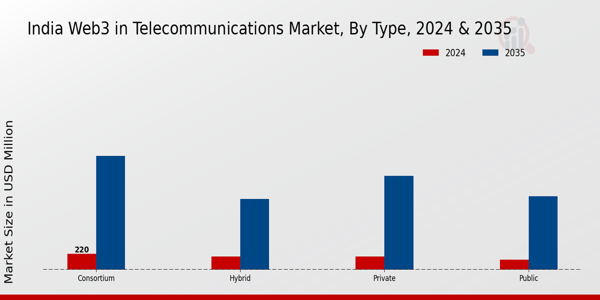India Web3 in Telecommunications Market Overview
As per MRFR analysis, the India Web3 in Telecommunications Market Size was estimated at 484.15 (USD Million) in 2023. The India Web3 in Telecommunications Market is expected to grow from 720.9(USD Million) in 2024 to 4,882 (USD Million) by 2035. The India Web3 in Telecommunications Market CAGR (growth rate) is expected to be around 18.993% during the forecast period (2025 - 2035)
Key India Web3 in Telecommunications Market Trends Highlighted
The India Web3 in Telecommunications market is experiencing significant growth driven by the increasing demand for secure and decentralized communication solutions. The adoption of blockchain technology in telecom operations is becoming a key market driver, as it enables enhanced security, transparency, and reduced operational costs. As telecom providers focus on improving customer experience and reducing fraudulent activities, leveraging blockchain for identity verification and smart contracts is gaining traction.
Opportunities are emerging for telecom companies to develop decentralized applications that cater to the evolving needs of consumers, such as improved data privacy and better connectivity.The government's push for digital India projects and the growth of the startup ecosystem give this sector more chances to come up with new ideas. Also, using Web3 technologies together can help telecom companies, content providers, and end users work better. Telecom companies and blockchain companies are working together more and more to find new ways to use their technologies. For example, decentralized finance (DeFi) and non-fungible tokens (NFTs) are becoming more popular with young people in India. The rules are also changing.
The government is working hard to make a set of rules that will protect users while also allowing new technologies to grow.The growing interest in remote work solutions and enhanced digital services amid the pandemic has also accelerated the push toward adopting Web3 capabilities in telecommunications, making it a vital area for future investment and development in India.

Source: Primary Research, Secondary Research, Market Research Future Database, and Analyst Review
India Web3 in Telecommunications Market Drivers
Rising Adoption of Blockchain Technology
The rapid adoption of Blockchain technology in India is a significant driver for the India Web3 in Telecommunications Market. According to the 'NASSCOM' report, the Indian Blockchain market is expected to grow at a Compound Annual Growth Rate (CAGR) of over 41% from 2020 to 2025. This growth is largely fueled by the increasing need for transparency, security, and efficiency in telecommunication operations. Major telecom operators like Reliance Jio and Bharti Airtel are exploring blockchain solutions for improved customer service and fraud reduction.
By implementing decentralized identity verification systems utilizing blockchain, these companies can potentially reduce operational costs by 30% or more, thereby driving the overall market growth. As the rate of mobile penetration in India reaches over 800 million subscribers, the integration of Web3 technologies into the telecommunications sector is expected to enhance user experiences and boost profitability in the coming years.
Government Initiatives and Support
The Indian government is actively promoting the use of advanced technologies, including Web3 and blockchain, which is fuelling growth in the India Web3 in Telecommunications Market. Initiatives such as the National Blockchain Strategy aim to position India as a global blockchain powerhouse. The government has also facilitated various funding and incubation programs that support startups working on decentralized technologies.
According to the Ministry of Electronics and Information Technology, over 700 blockchain projects are currently underway across various sectors, including telecommunications.These policies are projected to attract over USD 1 billion in investments by 2025, creating a robust ecosystem for the adoption of Web3 solutions in telecom.
Growing Demand for Data Privacy and Security
As cyber threats become increasingly sophisticated, the demand for enhanced data privacy and security is escalating, particularly within the telecommunications sector in India. A report by Cybersecurity Ventures suggests that cybercrime is predicted to cause damages of approximately USD 6 trillion globally by 2021, which underscores the critical need for secure communication systems.
Telecommunications companies, such as Vodafone Idea and BSNL, are shifting towards Web3 technologies to meet this demand by implementing secure data management systems based on decentralized protocols.This transition aligns with India's push for a Digital India initiative and the Personal Data Protection Bill, which aims to safeguard consumers' data rights. Consequently, this drive towards heightened data security is expected to significantly propel the India Web3 in Telecommunications Market.
India Web3 in Telecommunications Market Segment Insights
Web3 in Telecommunications Market Type Insights
The India Web3 in Telecommunications Market showcases a diverse landscape within its various types, significantly shaping the market's evolution. The presence of Public, Private, Consortium, and Hybrid models delineates key operational frameworks that drive innovation and adoption across the telecommunications sector. Public models, characterized by transparency and community governance, play a vital role in democratizing access to Web3 technologies, promoting user engagement, and fostering trust among consumers. Meanwhile, Private models cater to businesses seeking tailored solutions that enhance security and control over their data.
These models are essential as they address growing concerns related to data privacy and cybersecurity faced by enterprises across India.Consortium models arise through partnerships among companies, pooling resources and expertise to develop Web3 solutions collaboratively. This type emphasizes cooperation and shared governance, addressing complex challenges in the telecommunications sector and enhancing operational efficiencies. Hybrid models combine the strengths of both public and private frameworks, facilitating a multifaceted approach to nurturing innovation while retaining rigorous data governance.
This type promotes scalability and flexibility, making it appealing to a wide range of telecommunications players in India.The extensive growth of the India Web3 in Telecommunications Market is fueled by factors such as increasing mobile penetration, the rise of digital infrastructure, and the country's broad demographic diversity. These trends point toward an expanding user base that demands advanced telecommunication services powered by Web3 technologies. Challenges such as regulatory hurdles, digital divide concerns, and the need for an educated workforce in blockchain technologies will require ongoing attention from stakeholders.
Nevertheless, opportunities for growth remain substantial, driven by the ability of various types to adapt to evolving market needs and technological advancements, thus facilitating a brighter future for communication technologies in India. Emphasizing the nuances within each type allows for a more targeted and effective implementation of Web3 solutions, aligning with national goals towards a digitally empowered society.

Source: Primary Research, Secondary Research, Market Research Future Database, and Analyst Review
Web3 in Telecommunications Market Application Insights
The Application segment of the India Web3 in Telecommunications Market showcases a diverse array of innovative use cases, positioning itself as a pivotal player in the industry. This segment encompasses various essential areas, including Cryptocurrency, which has gained substantial traction among the Indian populace, reflecting a growing acceptance of decentralized finance. Conversational AI also stands out, seamlessly integrating into customer service solutions and personalizing user interactions, thereby enhancing operational efficiency for telecommunications providers.Data and Transaction Storage are significant due to the increasing need for secure, reliable data management systems, particularly in industries handling sensitive information.
Payment solutions within this segment leverage blockchain technology to offer enhanced security and transparency, which resonates well with India's digital payment landscape, being one of the fastest-growing worldwide. Smart Contracts streamline operations by automating processes, reducing the potential for errors, and fostering trust among users. Furthermore, other emerging applications of Web3 technology are gradually gaining momentum, indicating the rise of innovative solutions tailored to meet evolving market demands.Collectively, the Application segment is poised to drive substantial growth, contributing significantly to the evolution of the telecommunications sector in India.
India Web3 in Telecommunications Market Key Players and Competitive Insights
The India Web3 in Telecommunications Market is a rapidly evolving landscape characterized by the integration of blockchain technologies and decentralized applications that aim to enhance digital communication infrastructures. The competitive dynamics in this market are shaped by various factors, including the adoption of new technologies, regulatory frameworks, and emerging consumer preferences. As traditional telecommunications companies seek to transform their offerings, new entrants focused on leveraging Web3 capabilities are challenging the status quo, pushing for innovation in service delivery and user privacy.
A key aspect of this competition is the shift towards decentralized networks, which promise enhanced security, reduced operational costs, and improved customer experiences.Tech Mahindra has established itself as a significant player in the India Web3 in Telecommunications Market by providing a range of technology-driven solutions tailored to enhance connectivity and data management. The company's strengths lie in its robust capabilities in IT services and consulting, which enable it to assist telecommunications firms in embracing Web3 innovations. Tech Mahindra's focus on strategic partnerships and collaborative projects accelerates its ability to introduce blockchain-based solutions and decentralized frameworks. Its strong reputation in digital transformation positions it well to meet the growing demand for modern telecommunications services, allowing it to effectively compete against both established and emerging players in the Indian market.
BSNL, as a stalwart in the Indian telecommunications sector, is actively exploring the potential of Web3 technology to enhance its service delivery and operational efficiencies. The company's key products and services encompass a comprehensive suite of telecommunications offerings, including broadband, mobile, and fixed-line services. BSNL's extensive market presence across urban and rural areas ensures it remains a crucial player in facilitating connectivity in India. Its strengths include a well-established customer base, government backing, and a commitment to digital innovation, which allows it to invest in mergers and acquisitions that bolster its technological capabilities. By focusing on the applications of blockchain technology and decentralized networks, BSNL aims to improve service reliability and security, ultimately enhancing customer satisfaction while remaining competitive in the burgeoning Web3 telecommunications landscape.
Key Companies in the India Web3 in Telecommunications Market Include
- Tech Mahindra
- BSNL
- Reliance Industries
- Sify Technologies
- Vodafone Idea
- Telecom Sector Skill Council
- Wipro
- Mavenir
- Tata Communications
- HCL Technologies
- Zoho
- Bharti Airtel
- Nerolac
- Airtel Xstream
- Jio Platforms
India Web3 in Telecommunications Market Developments
Recent developments in the India Web3 in Telecommunications Market highlight significant advancements and shifts among key players. Tech Mahindra has been actively exploring Web3 technologies, while BSNL is focusing on integrating blockchain solutions for enhanced telecommunications services. Reliance Industries, through its subsidiary Jio Platforms, continues to invest heavily in Web3 initiatives to strengthen its market position. Vodafone Idea is also fostering innovations, aiming to enhance customer experience through decentralized applications.
Notably, Tata Communications announced its strategic partnership with Mavenir in September 2023, expanding its capabilities in cloud-native network solutions, which demonstrates the growing synergy between traditional telecom entities and emerging Web3 technologies. The valuation of companies like Bharti Airtel has shown growth, attributed to the increasing demand for seamless digital connectivity. The Telecom Sector Skill Council has been pivotal in promoting skills necessary for Web3 roles, emphasizing the changing landscape of jobs in the telecommunications sector. Over the past 2-3 years, significant investments have flowed into the market, revealing a transformative shift towards more innovative and decentralized telecommunications solutions, reshaping India's digital economy.
India Web3 in Telecommunications Market Segmentation Insights
Web3 in Telecommunications Market Type Outlook
- Public
- Private
- Consortium
- Hybrid
Web3 in Telecommunications Market Application Outlook
- Cryptocurrency
- Conversational AI
- Data & Transaction Storage
- Payments
- Smart Contracts
- Others
| Report Attribute/Metric Source: |
Details |
| MARKET SIZE 2023 |
484.15(USD Million) |
| MARKET SIZE 2024 |
720.9(USD Million) |
| MARKET SIZE 2035 |
4882.0(USD Million) |
| COMPOUND ANNUAL GROWTH RATE (CAGR) |
18.993% (2025 - 2035) |
| REPORT COVERAGE |
Revenue Forecast, Competitive Landscape, Growth Factors, and Trends |
| BASE YEAR |
2024 |
| MARKET FORECAST PERIOD |
2025 - 2035 |
| HISTORICAL DATA |
2019 - 2024 |
| MARKET FORECAST UNITS |
USD Million |
| KEY COMPANIES PROFILED |
Tech Mahindra, BSNL, Reliance Industries, Sify Technologies, Vodafone Idea, Telecom Sector Skill Council, Wipro, Mavenir, Tata Communications, HCL Technologies, Zoho, Bharti Airtel, Nerolac, Airtel Xstream, Jio Platforms |
| SEGMENTS COVERED |
Type, Application |
| KEY MARKET OPPORTUNITIES |
Decentralized identity solutions, Blockchain-based billing systems, Smart contracts for service agreements, Enhanced network security protocols, Peer-to-peer bandwidth sharing |
| KEY MARKET DYNAMICS |
Decentralization of services, Enhanced data security, Smart contracts adoption, Tokenization of assets, Regulatory compliance challenges |
| COUNTRIES COVERED |
India |
Frequently Asked Questions (FAQ):
The India Web3 in Telecommunications Market is expected to be valued at 720.9 million USD in 2024.
By 2035, the market is projected to reach a value of 4882.0 million USD.
The anticipated CAGR for the market from 2025 to 2035 is 18.993 percent.
The Consortium segment is expected to have a significant market presence, valued at 220.0 million USD in 2024 and projected to grow to 1580.0 million USD by 2035.
Major players include Tech Mahindra, BSNL, Reliance Industries, Sify Technologies, and Vodafone Idea.
The Public segment is projected to be valued at 140.0 million USD in 2024.
The Private segment is expected to reach a value of 1300.0 million USD by 2035.
The market is experiencing growth driven by the increasing adoption of decentralized technologies and digital transformations.
The growth rate is expected to be robust across all segments, particularly in Hybrid and Consortium types due to their increasing applications.
Challenges include regulatory hurdles and the need for significant investments to support infrastructure development.
















